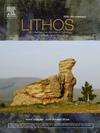The Eo-Variscan domain in the Variscan belt: New data from the Sudetes, southern Poland
IF 2.9
2区 地球科学
Q2 GEOCHEMISTRY & GEOPHYSICS
引用次数: 0
Abstract
The Variscan belt in Europe includes Eo-Variscan domains whose tectono-metamorphic evolution ended before the Carboniferous. In the Bohemian Massif, these are the Teplá-Barrandian terrain and the Góry Sowie Massif – Kłodzko Metamorphic Massif terrain, jointly referred to as the Bohemian Terrane, which is partially concealed beneath the North Bohemian Cretaceous Basin. Terrains on either side of this basin differ in several aspects. Northern Bohemia is accompanied by dismembered ophiolite (c. 400 Ma) and preserves fragments of late Devonian overstep succession – features missing in the Teplá-Barrandian terrain. New zircon U![]() Pb and O isotope analyses indicate that the Góry Sowie Massif is composed primarily of metasedimentary rocks with a maximum depositional age of 540 Ma, along with minor metaigneous rocks with protolith ages of c. 500–490 Ma. Oxygen isotope study suggests crustal derivation of felsic rocks (δ18OZrn values of 8.14–11.29 ‰) and local pulses of mantle melting for minor basites (δ18OZrn values of 5.10–8.36 ‰). Neither Cadomian basement nor Neoproterozoic magmatic arc, characteristic for the Teplá-Barrandian domain, is in evidence in the Góry Sowie Massif. Detrital zircon age spectra for the Góry Sowie Massif reveal three clusters: 2.8–2.4 Ga, 2.1–1.9 Ga, and 650–540 Ma also known from the adjacent Saxothuringian units. However, the Góry Sowie Massif spectra contain more Neoarchaean and Mesoproterozoic components, and fewer Neoproterozoic components, suggesting different positions for the Góry Sowie Massif and Saxothuringia in the peri-Gondwana realm during the Cambrian. The two Eo-Variscan parts of the Bohemian terrane have probably constituted the composite terrane of Bohemia since the Early/Middle Devonian and further acted as a single microcontinent. In the Góry Sowie Massif, metamorphic zircon grains dated to ca. 390–380 Ma preserve evidence of the mid-Devonian collision between the western margin of the Góry Sowie Massif–Kłodzko Metamorphic Massif block and the Saxothuringia-related sub-terrane. In the Kłodzko Metamorphic Massif, slightly metamorphosed mudstones (Frasnian depositional age), below the nonconformity, contain detrital zircons of metamorphic origin dated at c. 390–370 Ma, sourced from the Góry Sowie area. The Eo-Variscan domain was finally brought to the surface in the Frasnian/Famennian as constrained by previous biostratigraphical data from a nonconformably overstepping sedimentary succession on its flanks. The more distant Famennian pelagic deposits in the Bardo Structure acquired c. 390–365 Ma euhedral zircons of volcanogenic provenance, prior to the Variscan collision between the Saxothuringian and Bohemian terranes.
Pb and O isotope analyses indicate that the Góry Sowie Massif is composed primarily of metasedimentary rocks with a maximum depositional age of 540 Ma, along with minor metaigneous rocks with protolith ages of c. 500–490 Ma. Oxygen isotope study suggests crustal derivation of felsic rocks (δ18OZrn values of 8.14–11.29 ‰) and local pulses of mantle melting for minor basites (δ18OZrn values of 5.10–8.36 ‰). Neither Cadomian basement nor Neoproterozoic magmatic arc, characteristic for the Teplá-Barrandian domain, is in evidence in the Góry Sowie Massif. Detrital zircon age spectra for the Góry Sowie Massif reveal three clusters: 2.8–2.4 Ga, 2.1–1.9 Ga, and 650–540 Ma also known from the adjacent Saxothuringian units. However, the Góry Sowie Massif spectra contain more Neoarchaean and Mesoproterozoic components, and fewer Neoproterozoic components, suggesting different positions for the Góry Sowie Massif and Saxothuringia in the peri-Gondwana realm during the Cambrian. The two Eo-Variscan parts of the Bohemian terrane have probably constituted the composite terrane of Bohemia since the Early/Middle Devonian and further acted as a single microcontinent. In the Góry Sowie Massif, metamorphic zircon grains dated to ca. 390–380 Ma preserve evidence of the mid-Devonian collision between the western margin of the Góry Sowie Massif–Kłodzko Metamorphic Massif block and the Saxothuringia-related sub-terrane. In the Kłodzko Metamorphic Massif, slightly metamorphosed mudstones (Frasnian depositional age), below the nonconformity, contain detrital zircons of metamorphic origin dated at c. 390–370 Ma, sourced from the Góry Sowie area. The Eo-Variscan domain was finally brought to the surface in the Frasnian/Famennian as constrained by previous biostratigraphical data from a nonconformably overstepping sedimentary succession on its flanks. The more distant Famennian pelagic deposits in the Bardo Structure acquired c. 390–365 Ma euhedral zircons of volcanogenic provenance, prior to the Variscan collision between the Saxothuringian and Bohemian terranes.
Variscan带的Eo-Variscan域:来自波兰南部苏台德地区的新数据
欧洲的瓦里斯坎构造带包括第三纪-瓦里斯坎构造域,其构造变质演化结束于石炭纪之前。在波西米亚地块,这些是Teplá-Barrandian地形和Góry Sowie地块- Kłodzko变质地块地形,合称为波西米亚地体,部分隐藏在北波西米亚白垩纪盆地之下。这个盆地两侧的地形在几个方面有所不同。北波西米亚伴随着被肢解的蛇绿岩(约400 Ma),并保留了晚泥盆世超越演代的碎片- Teplá-Barrandian地形中缺失的特征。新锆石UPb和O同位素分析表明,Góry Sowie地块主要由变质沉积岩组成,最大沉积年龄为540 Ma,另有少量变质沉积岩,原岩年龄为500 ~ 490 Ma。氧同位素研究表明,长英质岩石(δ18OZrn值为8.14 ~ 11.29‰)的地壳成因和小基岩(δ18OZrn值为5.10 ~ 8.36‰)的局部地幔熔融脉冲。在Góry Sowie地块中,既没有发现Teplá-Barrandian域特有的Cadomian基底,也没有发现新元古代的岩浆弧。Góry Sowie地块的碎屑锆石年龄谱显示了三个星团:2.8-2.4 Ga, 2.1-1.9 Ga和650-540 Ma,这些星团也可以从邻近的Saxothuringian单元中找到。而Góry Sowie地块光谱中新太古代和中元古代成分较多,新元古代成分较少,说明Góry Sowie地块与Saxothuringia在寒武纪的近冈瓦纳域位置不同。早/中泥盆世以来,波西米亚地体的两个东—瓦里斯坎部分可能构成了波西米亚复合地体,并进一步成为一个单一的微大陆。在Góry Sowie地块,约390-380 Ma的变质锆石颗粒保存了Góry Sowie Massif-Kłodzko变质地块西缘与saxothuringia相关的地下地体之间中泥盆世碰撞的证据。在Kłodzko变质地块中,不整合面下方的微变质泥岩(frasian沉积时代)中含有变质锆石碎屑,产自Góry Sowie地区,年代约390-370 Ma。受其两侧不整合越级沉积序列的生物地层资料限制,上第三纪-瓦里斯坎域最终在弗拉斯纪/法门纪浮出水面。在萨克森图林根地体和波西米亚地体之间的Variscan碰撞之前,Bardo构造中较远的法门期中上层沉积物获得了c. 390-365 Ma的火山源自体锆石。
本文章由计算机程序翻译,如有差异,请以英文原文为准。
求助全文
约1分钟内获得全文
求助全文
来源期刊

Lithos
地学-地球化学与地球物理
CiteScore
6.80
自引率
11.40%
发文量
286
审稿时长
3.5 months
期刊介绍:
Lithos publishes original research papers on the petrology, geochemistry and petrogenesis of igneous and metamorphic rocks. Papers on mineralogy/mineral physics related to petrology and petrogenetic problems are also welcomed.
 求助内容:
求助内容: 应助结果提醒方式:
应助结果提醒方式:


